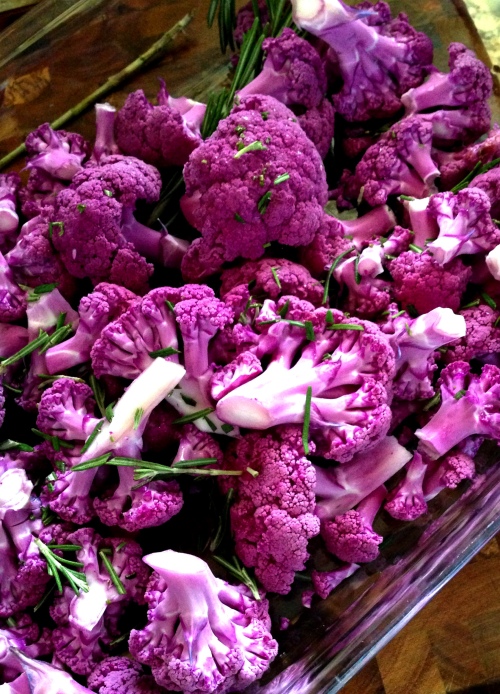I feel as though cauliflower has been far too under appreciated as a brassica in the vegetable kingdom. It has taken the back burner for far too long. I often see it as a side addition on the standard party vegetable tray, along side raw broccoli, the trusty stand-ins of carrots and celery, with the occasional radish and, of course, commercial ranch dip.
Cauliflower, though, is worth so much more.
Cauliflower has a long history. François Pierre La Varenne employed chouxfleurs in Le cuisinier françois. They were introduced to France from Genoa in the 16th century, and are featured in Olivier de Serres’Théâtre de l’agriculture (1600), as cauli-fiori “as the Italians call it, which are still rather rare in France; they hold an honorable place in the garden because of their delicacy”, but they did not commonly appear on grand tables until the time of Louis XIV.
Even more fascinating, which is a fact so commonly neglected and even unknown by the vast majority of Americanites:
There are hundreds of historic and current commercial varieties used around the world. A comprehensive list of about 80 North American varieties is maintained at North Carolina State University. (80 varieties ~ WOW!)
White: White cauliflower is the most common color of cauliflower.
Orange: Orange cauliflower (B. oleracea L. var. botrytis) contains 25% more vitamin A than white varieties.This trait came from a natural mutant found in a cauliflower field in Canada. Cultivars include ‘Cheddar’ and ‘Orange Bouquet’.
Green: Green cauliflower, of the B. oleracea botrytis group, is sometimes called broccoflower. It is available both with the normal curd shape and a variant spiky curd called Romanesco broccoli. Both types have been commercially available in the U.S. and Europe since the early 1990s. Green-curded varieties include ‘Alverda’, ‘Green Goddess’ and ‘Vorda’. Romanesco varieties include ‘Minaret’ and ‘Veronica’.
Purple: The purple color in this cauliflower is caused by the presence of the antioxidant group anthocyanins, which can also be found in red cabbage and red wine. Varieties include ‘Graffiti’ and ‘Purple Cape’. In Great Britain and southern Italy, a broccoli with tiny flower buds is sold as a vegetable under the name “purple cauliflower”. It is not the same as standard cauliflower with a purple curd.
As a lover of all things culinary, I have sampled, devoured, and noshed on all of the above varieties, and find the differences both incredibly and irresistibly fascinating.
I can prepare, eat, and enjoy a RAINBOW of gorgeous flowering buds: the cauliflower.
My favorite, though ~ purple, of course.
Coconut Roasted Purple Cauliflower with Fresh Rosemary
1 large head purple cauliflower, washed, trimmed, and broken into small flowerets
2 Tbs. fresh rosemary, minced
2 Tbs. extra virgin coconut oil (Gold Label Virgin from Tropical Traditions)
2 tsp. Himalayan sea salt
3 c. fresh baby spinach
4 large sausage links, cooked**
Preheat oven to 400 degrees. Toss all ingredients together in a glass baking tray. Cover tightly with foil and roast 30-35 minutes. Stir to evenly distribute oil (now melted). Return to the oven, uncovered, stirring every 3-5 minutes, allowing the coconut oil to create a perfect caramelized crust.
Immediately toss with fresh baby spinach leaves, allowing the leaves to wilt ever so slightly. Toss in sliced sausage links. (Turkey-kale sausage from Whole Foods Market worked wonders this time around).
**If you’re following the paleo autoimmune protocol, check the ingredients of any sausage you buy, to be sure there are no nightshade or seedbased spices.




